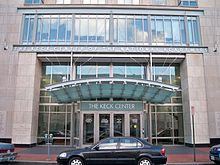National Academies (United States)

The Keck Center of the National Academies in Washington, D.C.
|
|
| Formation | 1863 (as National Academy of Sciences), 1916 (as National Resarch Council), 2015 (as National Academies of Sciences, Engineering, and Medicine) |
|---|---|
| Headquarters | Washington, D.C., U.S. |
|
Membership
|
Scientists, engineers, and health professionals |
|
Official language
|
English |
The National Academies of Sciences, Engineering, and Medicine (also known as "NASEM" or "the National Academies") is the collective scientific National Academy of the United States (US). The name is used interchangeably in two senses: (1) as an umbrella term for its three quasi-independent honorific member organizations (the National Academy of Sciences (NAS), the National Academy of Engineering (NAE), and the National Academy of Medicine (NAM)). And (2) as the imprint or brand for studies and reports issued by the operating arm of the three academies, the National Research Council (NRC). The NRC was first formed in 1916 as an activity of the NAS. Now jointly governed by all three academies, it produces some 200 public reports annually.
The US National Academy of Sciences was created by an Act of Incorporation in 1863, which was signed by the President of the United States Abraham Lincoln. All subsequently affiliated organizations have been created under this same overall congressional charter, including the two younger academies NAE (created in 1964) and NAM (created as the Institute of Medicine in 1970 and rechartered as NAM in 2015).
Under this same charter, the National Research Council was created in 1916. On June 19 of that year, then US President Woodrow Wilson requested that the National Academy of Sciences organize a "National Research Council". The purpose of the Council (at first called the National Research Foundation) was in part to foster and encourage "the increased use of scientific research in the development of American industries ... the employment of scientific methods in strengthening the national defense ... and such other applications of science as will promote the national security and welfare."
At the time, the Academy's effort to support national defense readiness, the Committee on Nitric Acid Supply, was approved by Secretary of War Newton D. Baker. Nitric acid was the substance basic in the making of propellants such as cordite, high explosives, dyes, fertilizers, and other products but availability was limited due to World War I. The NRC, through its committee, recommended importing Chilean saltpeter and the construction of four new ordinance plants. These recommendations were accepted by the War Department in June 1917, although the plants were not completed prior to the end of the war. In 1918, Wilson formalized the NRC's existence under Executive Order 2859. During World War I the United States was at war, the NRC operated as the Department of Science and Research of the Council of National Defense as well as the Science and Research Division of the United States Army Signal Corps. When war was first declared, the Council had organized committees on antisubmarine and gas warfare.
...
Wikipedia
